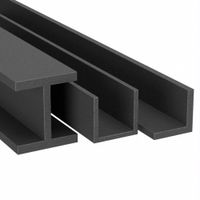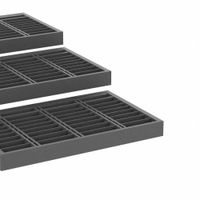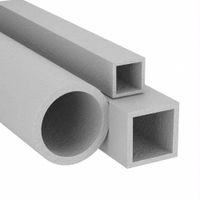Call +(254) 703 030 000 / 751 483 999 / 721 704 777
- Home
- Raw Materials
- Fiberglass Carbon Fiber Composites
- Structural Fiberglass Reinforced Plastics
.....Read More
Frequently Asked Questions
What is structural fiberglass used for?
Structural fiberglass is used in a variety of applications due to its strength, durability, and resistance to environmental factors. It is commonly employed in the construction industry for building components such as beams, columns, and panels, offering a lightweight alternative to traditional materials like steel and wood. Its corrosion resistance makes it ideal for use in environments exposed to moisture, chemicals, or saltwater, such as in marine applications for boat hulls, decks, and docks.
In infrastructure, structural fiberglass is used for bridges, walkways, and railings, providing long-lasting solutions with minimal maintenance. It is also utilized in the manufacturing of utility poles and crossarms, where its non-conductive properties are advantageous for electrical safety.
The transportation sector benefits from structural fiberglass in the production of vehicle components, including body panels and frames, due to its ability to reduce weight and improve fuel efficiency. In the aerospace industry, it is used for aircraft components, offering a balance of strength and weight reduction.
Additionally, structural fiberglass is employed in the production of storage tanks and piping systems, particularly in industries dealing with corrosive substances. Its versatility extends to architectural applications, where it is used for decorative elements, facades, and roofing.
Overall, structural fiberglass is valued for its combination of strength, lightweight nature, corrosion resistance, and versatility, making it a preferred material across various industries for both functional and aesthetic purposes.
How strong is structural fiberglass compared to metal?
Structural fiberglass, often referred to as fiberglass-reinforced plastic (FRP), is a composite material known for its high strength-to-weight ratio, corrosion resistance, and versatility. When compared to metals, the strength of structural fiberglass can vary depending on the specific type of metal and the application.
1. **Strength-to-Weight Ratio**: Fiberglass has a superior strength-to-weight ratio compared to many metals. It is lighter than steel and aluminum, which makes it advantageous in applications where weight reduction is crucial, such as in aerospace and automotive industries.
2. **Tensile Strength**: Fiberglass can have a tensile strength comparable to that of some metals. For instance, E-glass fiberglass can have a tensile strength of around 3450 MPa, which is higher than that of many aluminum alloys but lower than high-strength steels.
3. **Corrosion Resistance**: Unlike metals, fiberglass does not corrode, making it ideal for use in harsh environments, such as marine applications or chemical processing plants, where metals might degrade over time.
4. **Impact Resistance**: Fiberglass can absorb impact energy better than some metals, which can make it more durable in certain applications. However, it can be more brittle than metals like steel, which can deform under stress without breaking.
5. **Thermal and Electrical Insulation**: Fiberglass is a poor conductor of heat and electricity, providing advantages over metals in applications requiring thermal or electrical insulation.
6. **Cost and Maintenance**: While the initial cost of fiberglass can be higher than some metals, its low maintenance requirements and long lifespan can make it more cost-effective over time.
In summary, structural fiberglass offers distinct advantages over metals in terms of weight, corrosion resistance, and specific strength, but the choice between fiberglass and metal will depend on the specific requirements of the application.
What are the advantages of using structural fiberglass?
Structural fiberglass offers several advantages:
1. **Corrosion Resistance**: Unlike metals, fiberglass does not rust or corrode, making it ideal for use in harsh environments, such as marine, chemical, and industrial applications.
2. **Lightweight**: Fiberglass is significantly lighter than traditional materials like steel and aluminum, which reduces transportation and installation costs and makes handling easier.
3. **High Strength-to-Weight Ratio**: Despite its lightweight nature, fiberglass provides excellent strength, making it suitable for structural applications where weight savings are crucial.
4. **Durability**: Fiberglass is highly durable and can withstand extreme weather conditions, UV exposure, and temperature fluctuations without degrading.
5. **Low Maintenance**: The material requires minimal maintenance over its lifespan, reducing long-term costs associated with upkeep and repairs.
6. **Non-Conductive**: Fiberglass is an excellent insulator, both thermally and electrically, making it safe for use in electrical applications and environments where conductivity is a concern.
7. **Design Flexibility**: It can be molded into complex shapes and sizes, allowing for innovative design solutions and customization to meet specific project requirements.
8. **Fire Resistance**: Certain formulations of fiberglass are fire-retardant, providing an added layer of safety in applications where fire resistance is necessary.
9. **Cost-Effective**: While the initial cost may be higher than some materials, the long-term savings in maintenance, durability, and performance often make it a cost-effective choice.
10. **Environmental Benefits**: Fiberglass can be manufactured using recycled materials and is itself recyclable, contributing to sustainability efforts.
These advantages make structural fiberglass a versatile and efficient choice for a wide range of applications, from construction and infrastructure to transportation and energy sectors.
How is structural fiberglass made?
Structural fiberglass is made through a process called pultrusion, which involves several key steps:
1. **Raw Materials**: The process begins with raw materials, primarily glass fibers and a resin matrix. Glass fibers are typically made from silica sand, limestone, and other minerals, which are melted and extruded into thin strands.
2. **Fiber Formation**: These glass fibers are drawn into continuous strands and wound onto spools. The fibers are then unwound and aligned in a specific orientation to provide the desired strength and structural properties.
3. **Resin Impregnation**: The aligned glass fibers are pulled through a resin bath where they are thoroughly impregnated with a thermosetting resin, such as polyester, vinyl ester, or epoxy. This resin acts as a binding agent, holding the fibers together and providing additional strength and rigidity.
4. **Preforming**: After impregnation, the resin-coated fibers are shaped into the desired profile using a series of forming guides and preformers. This step ensures that the fibers are properly aligned and the resin is evenly distributed.
5. **Curing**: The preformed material is then pulled through a heated die, where the resin cures and hardens. The heat and pressure applied in the die ensure that the material solidifies into a rigid, structural shape.
6. **Cutting and Finishing**: Once cured, the continuous length of structural fiberglass is cut to the desired length. The finished product may undergo additional finishing processes, such as sanding or coating, to enhance its appearance and performance.
7. **Quality Control**: Finally, the structural fiberglass is subjected to quality control tests to ensure it meets the required specifications and standards for strength, durability, and other properties.
This process results in a lightweight, strong, and corrosion-resistant material suitable for various structural applications.
Can structural fiberglass be used outdoors?
Yes, structural fiberglass can be used outdoors. It is a highly durable material that is resistant to various environmental factors, making it suitable for outdoor applications. Fiberglass is composed of a matrix of glass fibers embedded in a resin, which provides excellent strength-to-weight ratio and resistance to corrosion, moisture, and UV radiation. These properties make it ideal for use in outdoor structures such as bridges, walkways, railings, and utility poles.
Fiberglass does not rust or corrode like metal, and it does not rot or warp like wood, which ensures longevity and minimal maintenance when exposed to outdoor conditions. Its resistance to UV radiation helps prevent degradation and discoloration from prolonged sun exposure. Additionally, fiberglass is non-conductive, making it a safe choice for applications near electrical installations.
The material's versatility allows it to be molded into various shapes and sizes, accommodating a wide range of design requirements. It can also be manufactured with different surface finishes and colors, providing aesthetic flexibility for outdoor projects.
However, while fiberglass is highly durable, it is essential to ensure proper installation and maintenance to maximize its lifespan. Regular inspections and cleaning can help maintain its appearance and structural integrity. In some cases, protective coatings may be applied to enhance UV resistance and surface durability.
Overall, structural fiberglass is a reliable and effective material for outdoor use, offering a combination of strength, durability, and low maintenance that is well-suited for various environmental conditions.
Is structural fiberglass resistant to corrosion?
Yes, structural fiberglass is resistant to corrosion. Fiberglass, a composite material made from a polymer matrix reinforced with glass fibers, exhibits excellent resistance to a wide range of corrosive environments. This resistance is primarily due to the inert nature of the glass fibers and the chemical stability of the resin matrix, typically made from polyester, vinyl ester, or epoxy resins.
The glass fibers themselves are non-reactive and do not corrode, unlike metals which can oxidize or rust when exposed to moisture and chemicals. The resin matrix acts as a protective barrier, preventing corrosive substances from reaching the fibers. This combination makes fiberglass highly suitable for applications in harsh environments, such as chemical processing plants, marine settings, and wastewater treatment facilities.
Fiberglass structures can withstand exposure to saltwater, acids, alkalis, and various industrial chemicals without degrading. This property significantly extends the lifespan of fiberglass components compared to traditional materials like steel or aluminum, which may require frequent maintenance or replacement due to corrosion.
Additionally, fiberglass does not suffer from galvanic corrosion, a common issue in metal structures where different metals in contact with each other corrode due to electrochemical reactions. This makes fiberglass an ideal choice for applications where dissimilar materials are used together.
Overall, the corrosion resistance of structural fiberglass contributes to its durability, low maintenance requirements, and cost-effectiveness over time, making it a preferred material in many industries where corrosion is a concern.
How does the cost of structural fiberglass compare to other materials?
The cost of structural fiberglass is generally higher than traditional materials like wood, steel, and aluminum, but it offers several advantages that can justify the expense depending on the application.
Fiberglass is more expensive than wood, primarily due to the manufacturing process and raw material costs. However, it offers superior durability, resistance to rot, and lower maintenance costs, which can make it more cost-effective over the long term, especially in environments exposed to moisture or chemicals.
Compared to steel, fiberglass is often more costly upfront. Steel is widely available and has a lower initial cost, but fiberglass is lighter, which can reduce transportation and installation expenses. Additionally, fiberglass does not corrode, which can lead to savings on maintenance and replacement in corrosive environments.
When compared to aluminum, fiberglass can be similarly priced or slightly more expensive. Aluminum is lightweight and resistant to corrosion, but fiberglass offers better thermal insulation and can be more cost-effective in applications where thermal efficiency is crucial.
Overall, while the initial cost of structural fiberglass may be higher than some traditional materials, its benefits in terms of durability, maintenance, and performance in specific environments can lead to lower total lifecycle costs. The decision to use fiberglass should consider these factors along with the specific requirements of the project.




